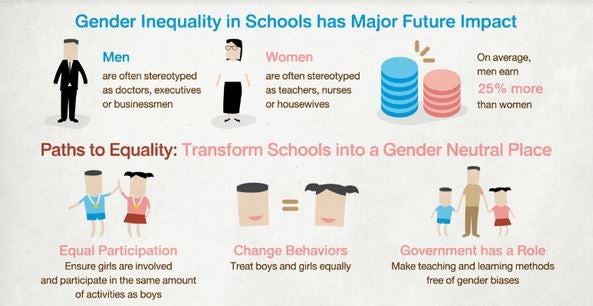Also available in: Français | العربية
While waiting to interview a teacher at one remote school in Thailand, the lunch scene reminded me of my childhood years in school. I spoke to the young boys and girls asking them what they wanted to be when they grow up. “I want to be a doctor,” one boy said and “I want to be a nurse when I grow up” said another girl. Their answers left me wondering how young we were when our gender values formed.Families and schools are the key institutions where young children learn social norms.
Schools, in particular, provide the playground for children to socialize and work out their social values and relationships, including gender.
The impact of schools in forming gender values is believed to be high, but in the past there has been little evidence-based research in Thailand to generate understanding on this issue.
Last year, the Promoting and Coordinating Women’s Affairs Committee (PCWA) conducted two studies, supported by the Rockefeller Foundation and the World Bank, to provide evidence-based research on the gender situation in the Thai education system. It aims to help strengthen or dispel assumptions about how gender biases and stereotypes are learned, taught, shared and transmitted in Thailand.
The first study uses a content analysis technique to examine textbooks and identify how gender role is perceived and portrayed in the curriculum. The second study uses quantitative and cross-sectional research, focusing on:
(1) Space utilization and sports
(2) Color selection and extracurricular activities
(3) Leadership of boys and girls
(4) Perceived academic aptitude
(5) Perceived desirable and undesirable characteristics of boys and girls

The study finds that deep-seated values and beliefs on gender differences permeate the entire school system.
Although younger boys and girls at the kindergarten and primary school levels have not yet formed clear-cut gender identities, the gender prejudices and biases have certainly started through various school practices and curriculum. The social value attached to ‘maleness’ and ‘femaleness’ were transmitted and can be seen through the teachers’ attitudes and beliefs, which are neither conscious nor intentional, and are further reinforced by the media, textbooks, schools and parental practices.
These deep-seated gender values drive gender inequality in the society today. Although Thai girls have outnumbered and outperformed boys in their schooling, girls’ achievements in school do not necessarily translate into better job opportunities or better pay. Nor in the advancement to top-level management in both public and private sectors in Thailand.
Some of the interesting findings are captured below and in this infographic:
Textbooks and Curriculum: Across the 538 textbooks that were randomly selected for content analysis, boys and men are more represented. Girls and women are often represented in an inferior position to men in terms of roles, functions, duties, and activities. Men are depicted as having leadership and professional roles (kings, philosophers, medical doctors) while women are confined to being wives and assuming a minor role in society.
Leadership of Boy and Girls: A survey finds that there is a tendency to believe that girls have less natural abilities to be leaders than boys. Boys are perceived to possess decisiveness, courage and generosity, whereas girls are viewed to be compromising, delicate and flexible.
Perceived Academic Aptitude: While teachers would express that boys and girls have no innate differences in aptitude and abilities, girls are viewed to do less well than boys in math and science.
Perceived Desirable and Undesirable Characteristics of Boys and Girls: Thai teachers expect girls to have ‘proper conduct’, to confirm and act ‘nice’ as Thai society expects from Thai women while boys can sometimes be naughty, say vulgar words and act aggressively.
So do we grow up to be what we are taught? Since schools offer the best environment to foster gender equality, what is needed to create change?
We believe that a strong political will is needed, but teachers also need to be trained and textbooks changed to eliminate how girls, boys, men and women are represented. The entire school staff should be on board and outreach programs to parents should be encouraged to help schools become a gender neutral place.


Join the Conversation